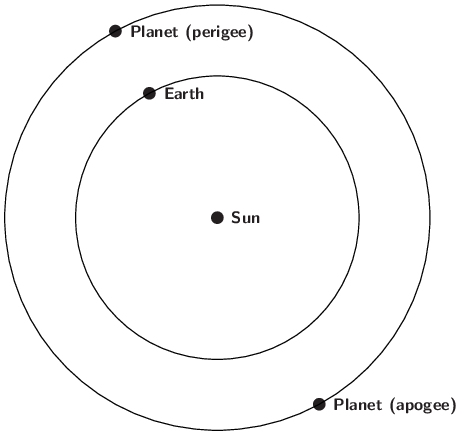Mars will reach opposition – the optimal time to observe it, when it will be visible for much of the night in the constellation Pisces. At this time, it also appears brightest in the sky and at its largest when viewed through a telescope.
From South El Monte, it will be visible between 19:08 and 06:19. It will become accessible at around 19:08, when it rises to an altitude of 7° above your eastern horizon. It will reach its highest point in the sky at 00:44, 61° above your southern horizon. It will become inaccessible at around 06:19 when it sinks below 7° above your western horizon.
Mars: our close neighbor
Of all the planets, Mars shows the greatest variation in its apparent size and brightness. Its angular size varies by a factor of more than seven, between 25.69" and 3.49".
This comes about because it neighbors the Earth in the solar system, orbiting the Sun at a distance of about 1.5 times the Earth's distance from the Sun. Its distance from the Earth varies greatly, between 0.36 AU when it lies next to the Earth in its orbit, and 2.68 AU. when it lies on the opposite side of the solar system.
The geometry of Mars' orbit is such that it spends much longer periods of time at large distances from the Earth than it does close to us, which makes the few weeks around opposition an especially rare opportunity to catch a detailed view of its surface. Each time it passes opposition, once every two years, this opportunity only lasts for a few weeks. The panels below show the month-by-month change in Mars' apparent size in the four months around opposition.
This data is also available in the form of a graph of the angular size of Mars here, and a graph of its brightness here.
A close approach to the Earth

When a planet is at opposition, the solar system is aligned with that planet on the same side of the Sun as the Earth.
The term opposition refers to the moment when a planet passes opposite to the Sun in the sky. For those planets which orbit the Sun at a greater distance than the Earth – like Mars – this geometry occurs as the two planets pass each other in their orbits and they make closest approach – termed its perigee.
At opposition / perigee, planets are visible for much of the night, reaching their highest point in the sky around midnight local time, just as the Sun, 180° away, dips to its lowest point below the horizon.
Because it passes closest to the Earth at this time, the planet also appears at its brightest and largest around opposition.
The panels below show a comparison of the apparent size of Mars when seen at opposition in 2020, and when it is most distant from the Earth at solar conjunction.
Seasonal variation
The charts also show that Mars does not always appear with the same angular size at opposition: in fact its size at closest approach can be anywhere between 13.7" and 25.7".
This comes about because Mars has the second most elliptical orbit of the solar system's planets. Its distance from the Sun varies between 1.38 and 1.67 AU.
As seen from the Earth, the variation in the distance of Mars from the Sun appears exaggerated by the fact that the Earth remains at an almost constant distance from the Sun, not far away. Mars's elliptical orbit gives rise to a much larger relative change in its distance from the Earth than it does in its relative distance from the Sun.
This elliptical path means that Mars's closest approaches to the Earth do not always bring it to exactly the same distance from the Earth. When an opposition occurs at any given time of year, Mars – by the definition of an opposition – must lie immediately alongside the part of the Earth's orbit where the Earth is found at that time of year.
For example, whenever Mars comes to an opposition in late August, it is always at roughly the same point along its orbit, next to where the Earth lies every year in late August. It so happens that this point is very close to the position where Mars makes its closest approach to the Sun – its perihelion. This also brings it closer to the Earth than is possible at any other time, and it may briefly come within a distance of 0.4 AU of us.
Observing Mars
At opposition, Mars is visible for much of the night. Even when it is at its closest point to the Earth, however, it is not possible to distinguish it as more than a star-like point of light without the aid of a telescope.
A chart of the path of Mars across the sky in 2020 can be found here, and a chart of its rising and setting times here.
The table below lists Mars' angular size and brightness at two-week intervals throughout its apparition:
| Date | Right ascension | Declination | Angular size | Magnitude |
| 04 Aug 2020 | 01h18m20s | 4°02'N | 15.1” | -1.2 |
| 18 Aug 2020 | 01h37m10s | 5°39'N | 17.0” | -1.5 |
| 01 Sep 2020 | 01h47m50s | 6°34'N | 19.0” | -1.8 |
| 15 Sep 2020 | 01h48m20s | 6°43'N | 21.1” | -2.2 |
| 29 Sep 2020 | 01h38m10s | 6°11'N | 22.4” | -2.5 |
| 13 Oct 2020 | 01h21m20s | 5°20'N | 22.3” | -2.6 |
| 27 Oct 2020 | 01h05m10s | 4°44'N | 20.7” | -2.3 |
| 10 Nov 2020 | 00h56m50s | 4°54'N | 18.2” | -1.8 |
| 24 Nov 2020 | 00h58m20s | 5°53'N | 15.6” | -1.3 |
| 08 Dec 2020 | 01h08m30s | 7°33'N | 13.3” | -0.9 |
| 22 Dec 2020 | 01h25m30s | 9°42'N | 11.4” | -0.5 |
At the moment of opposition, Mars will lie at a distance of 0.42 AU, and its disk will measure 22.3 arcsec in diameter, shining at magnitude -2.6. At opposition, its celestial coordinates will be:
| Object | Right Ascension | Declination | Constellation | Magnitude | Angular Size |
| Mars | 01h21m20s | 5°20'N | Pisces | -2.6 | 22.3" |
The coordinates above are given in J2000.0.
Over the weeks following its opposition, Mars will reach its highest point in the sky around four minutes earlier each night, gradually receding from the pre-dawn morning sky while remaining visible in the evening sky for a few months.
The sky on 13 Oct 2020
| The sky on 13 October 2020 | ||||||||||||||||||||||||||||||||||
|
7% 27 days old |
All times shown in PDT.
|
|||||||||||||||||||||||||||||||||
Source
The circumstances of this event were computed using the DE430 planetary ephemeris published by the Jet Propulsion Laboratory (JPL).
This event was automatically generated by searching the ephemeris for planetary alignments which are of interest to amateur astronomers, and the text above was generated based on an estimate of your location.
Related news
| 13 Oct 2020 | – Mars at opposition |
| 13 Nov 2020 | – Mars ends retrograde motion |
| 30 Oct 2022 | – Mars enters retrograde motion |
| 30 Nov 2022 | – Mars at perigee |
Image credit
© NASA/Hubble Space Telescope


